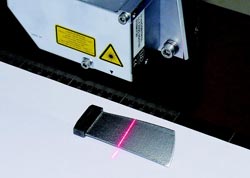New CAM system for efficient laser material deposition

Digitization of the surface of the part being worked on using an integrated laser line scanner.<br><br>Fraunhofer ILT, Aachen, Germany<br>
The generated paths are translated into machine code, and can be tested for possible collisions via a machine simulation. LACam3D will be presented for the first time at the EuroMold from November 27.-30., 2012 in Frankfurt at the Fraunhofer joint booth, hall 11- C66a.
Unique characteristics of laser material deposition (LMD) in comparison with conventional processes are e.g. the minimalized heat input and low levels of distortion. Combined with the high degree of process accuracy and the potential for automation it offers, this results in LMD becoming increasingly important for industrial applications such as an additive, repair or manufacturing process.
Path planning
The additive manufacture of parts using LMD involves the CAD model of the part being split into horizontal, cross-sectional layers that correspond to the direction in which the part is to be built up. These are then filled out using equidistant tool paths or parallel paths, being projected onto the welding surface, according to the strategy that has been selected. For the repair of parts that have suffered operational wear and tear, the actual geometry is first measured using a laser line scanner to generate a point cloud, from which a surface model is made using reverse engineering. The volume of the defect is ascertained by determining the best fit between the actual geometry and the CAD model of the component, and is then built up using LMD.
Functionalities
LaCam3D provides functionalities for LMD strategies that enable the LMD sequence and welding direction of individual paths to be modified. Parameters like laser power and velocity can be specified and tuned for each individual tool path. When designating tool paths to fill the various layers, the user can choose between equidistant paths and parallel paths that are projected onto the surface of the layer. The paths are automatically cropped to keep within the boundary marking the edge of the defect area. The paths are planned in such a way as to allow enough oversize for the finishing process that follows, in which excess material is machined. There is a specifically designed module available to help plan paths for turbine parts made using additive manufacturing. Due to its modular structure, the program can be complemented as necessary for various applications by further modules.
Collision testing
LaCam3D is equipped with a simulation tool that can check in advance whether the planned LMD process will cause the laser processing head to collide with the part. The machine code is generated using an integrated postprocessor that supports a full range of different systems.
Modularity
As a CAM module for LMD, LaCam3D’s functionalities are designed in such a way that the process developer and end-user can generate LMD paths immediately, even for complex LMD jobs with non-standard LMD strategies. The modular structure of the program allows additional algorithms of particular LMD strategies to be integrated. Currently, a prototype of LaCam3D is used at Fraunhofer ILT in Aachen for about 2 years now, and that they are continuing to develop.
Contacts
Dr. Norbert Pirch
Competence Area Additive Manufacturing and Functional Layers
Phone +49 241 8906-636
norbert.pirch@ilt.fraunhofer.de
Dipl.-Phys. John Flemmer
Polishing Group
Phone +49 241 8906-137
john.flemmer@ilt.fraunhofer.de
Fraunhofer Institute for Laser Technology ILT
Steinbachstraße 15
52074 Aachen, Germany
Phone +49 241 8906-0
Fax +49 241 8906-121
Media Contact
More Information:
http://www.ilt.fraunhofer.deAll latest news from the category: Trade Fair News
Newest articles

Machine learning algorithm reveals long-theorized glass phase in crystal
Scientists have found evidence of an elusive, glassy phase of matter that emerges when a crystal’s perfect internal pattern is disrupted. X-ray technology and machine learning converge to shed light…

Mapping plant functional diversity from space
HKU ecologists revolutionize ecosystem monitoring with novel field-satellite integration. An international team of researchers, led by Professor Jin WU from the School of Biological Sciences at The University of Hong…

Inverters with constant full load capability
…enable an increase in the performance of electric drives. Overheating components significantly limit the performance of drivetrains in electric vehicles. Inverters in particular are subject to a high thermal load,…





















